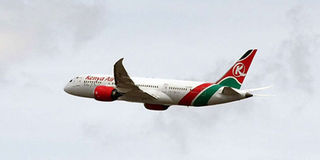KQ pains: It was once the Pride of Africa, so what went wrong?

A Kenya Airways plane flies over Nairobi on March 27, 2019. PHOTO | FILE | NATION MEDIA GROUP
What you need to know:
- KQ is having troubles at a time when Uganda Airlines and Air Tanzania have been revived, fuelling debate about whether they can buck the trend and be profitable.
- It seems on this continent, only the Ethiopians know how to run an airline profitably. In South Africa, once seemingly mighty South African Airlines is bleeding the taxpayers to death.
Kenya Airways has made another loss; this time posting a Sh7.55 billion ($74.93 million) net loss for the year ended December 2018.
These days it seems KQ, as its popularly known by its international code, can do no right.
KQ is having troubles at a time when Uganda Airlines and Air Tanzania have been revived, fuelling debate about whether they can buck the trend and be profitable.
This, given the fact that the other East African Community zone national carrier, RwandAir, is also still loss making.
It seems on this continent, only the Ethiopians know how to run an airline profitably. In South Africa, once seemingly mighty South African Airlines (SAA) is bleeding the taxpayers to death.
Airlines, as several other recent global failures testify, are hard to run, so we shall not jump on the back of KQ and others for now.
ETHIOPIAN WAR
I was once a big KQ fan. It was at a time when it was much beloved, and was raining profits. Which raises the question: was it beloved because it was doing well, or was it doing well because it was beloved?
I think it was doing well because it was loved. Also, that airlines in Africa do well when they are being more than an airline.
Consider this: In the last weeks of the Ethiopian war in 1991 that brought the still-ruling Ethiopian People’s Revolutionary Democratic Front (EPRDF) and its mercurial but charismatic and cerebral leader Meles Zenawi to power, there was a big writers’ conference in Tunis.
I was still a young adventurous chap, and when I got an invitation to attend, in the exciting period of the post-Cold War era, I couldn’t pass it up.
Except, given how difficult it still was to get around Africa, I was left scratching my head how I would get from Kampala to Tunis.
I was told I would have to get to Nairobi and go to Ethiopian Airlines (ET) to get a ticket. And so I did.
SUCCESS
Ethiopian Airlines, in the last weeks of the war, had packed and shifted its Africa and global operations to Nairobi.
There were many of us from the far corners of Africa who gathered in Nairobi at that time to get on Ethiopian Airlines to travel for the Tunis conference. It delivered us and back.
In the popular imagination, ET was the thing that took you to places in Africa that seemed impossible to reach without making the detour to Europe first.
And, as evident in that move to Nairobi, spared no imagination or effort to keep flying. In that context, the seediness of Bole International Airport, which still linger, seemed to be a necessary austerity.
If they were the only ones who could get you from East Africa to Ouagadougou then, having to walk over other people’s urine in the loo at Bole seemed to be a small price to pay.
Ethiopian success today is still partly steeped in that history. In what it did for Africa’s travelling masses, not in its comfort, or the quality of its on-board meals.
NAIKUNI
And so was KQ once. So what was it about it in the early 2000s that allowed KQ to soar?
Many people like to blame Titus Naikuni for the airline’s current troubles, but that does not explain how come he also presided over its glory period.
Anyone, if they were attentive, who dealt with Naikuni in that period, would have been struck by how much he understood the moment Kenya and Africa was in.
Rwanda was beginning to climb out of the hole it had fallen into after the 1994 genocide against the Tutsis. Tanzania had completed its second democratic leadership transition.
Kenya had been in the doghouse, but Narc had taken power in the first defeat of a ruling party by the opposition in the EAC zone.
Narc was the second broadest democratic coalition to take power in Africa after the ANC in South Africa. We had just had a revival of the EAC itself.
GLOBALISATION
Though Somalia was still in turmoil, and Sudan was trapped in a bloody civil war, East Africa was waiting for someone to cash in on its optimism. And in national terms to embody the spirit of Kenyan rebirth.
Under Naikuni, KQ came to symbolise all that. Almost single-handedly, it took East Africa to the world, and opened up possibilities.
Part of the evidence for that was in its in-flight magazine Msafiri. You could read it for an hour. In recent times, I hardly look at it. But ET’s Selamta still has some gems.
It might not be possible to fix KQ by fixing KQ. It is probably Kenya that needs to conjure up a dream, a new purpose, for KQ to sell.
Mr Onyango-Obbo is the publisher of Africapedia.com and explainer Roguechiefs.com. @cobbo3





